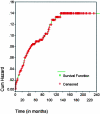Long-term failure after restorative proctocolectomy for ulcerative colitis
- PMID: 12894016
- PMCID: PMC1422693
- DOI: 10.1097/01.sla.0000082121.84763.4c
Long-term failure after restorative proctocolectomy for ulcerative colitis
Abstract
Objective: To establish the incidence and causes of late failure in patients undergoing restorative proctocolectomy for a preoperative diagnosis of ulcerative colitis was the objective of this investigation.
Summary background data: Restorative proctocolectomy is the elective surgical procedure of choice for ulcerative colitis. Most patients have a satisfactory outcome but failures occur. The reasons and rates of early failure are well documented, but there is little information on long-term failure.
Methods: A series of 634 patients (298 females, 336 males) underwent restorative proctocolectomy for inflammatory bowel disease between 1976-1997, with a mean follow-up of 85 +/- 58 months. Failure was defined as removal of the pouch or the need for an indefinite ileostomy. It was divided into early and late, occurring within 1 year or more than 1 year postoperatively. RESULTS There were 3 (0.5%) postoperative deaths, leaving 631 patients for analysis. Of these, 23 subsequently died (disseminated large bowel cancer, 12; unrelated causes, 9; related causes, 2). There were 61 (9.7%) failures (15 early [25%], 46 late [75%]) due to pelvic sepsis (32 [52%]: 7 early, 25 late), poor function (18 [30%]: 2 early, 16 late), pouchitis (7 [11%]: 2 early, 5 late) and miscellaneous (4, all early). A final diagnosis of Crohn's disease, type of reservoir (J,S), female gender, postoperative pelvic sepsis and a one-stage procedure were significantly associated with failure. Failure rate rose with time of follow-up from 9% at 5 years to 13% at 10 years.
Conclusions: Pelvic sepsis and poor function were the main reasons for later failure. Failure rates should be reported based on the duration of follow-up.
Figures
References
-
- Nicholls RJ, Moskowitz RL, Shepherd NA. Restorative proctocolectomy with ileal reservoir. Br J Surg. 1985;72:S76–S79. - PubMed
-
- Wexner SD, Wong WD, Rothenberger DA, et al. The ileoanal reservoir. Am J Surg. 1990;159:178–185. - PubMed
-
- Kelly KA. Anal sphincter saving operations for chronic ulcerative colitis. Am J Surg. 1992;1:5–11. - PubMed
-
- Becker JM. Surgical management of inflammatory bowel disease. Curr Opin Gastroenterol. 1993;9:600–615.
-
- Gemlo BT, Wong WD, Rothenberger DA, et al. Ileal pouch anal anastomosis—patterns of failure. Arch Surg. 1992;127:784–787. - PubMed
MeSH terms
LinkOut - more resources
Full Text Sources
Medical




